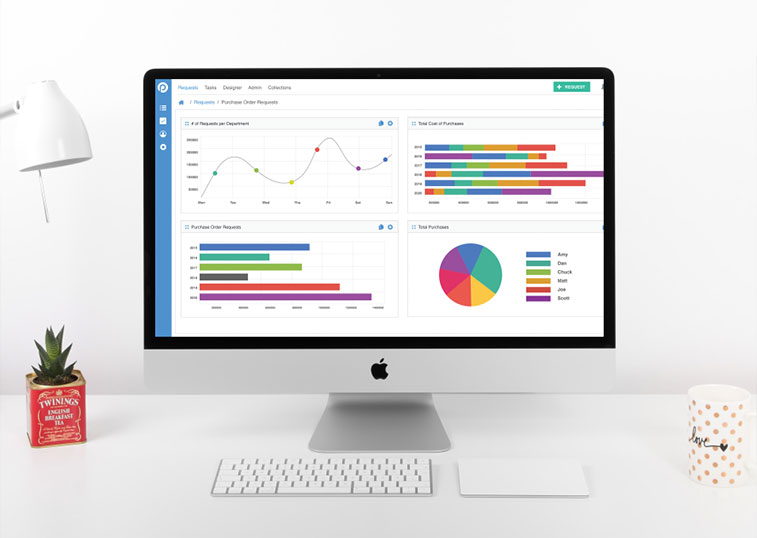Smartphones transformed every aspect of our lives into a tap on a screen: order flowers for your grandmother, find a date for Saturday night, and send your co-worker $50 to cover your half of yesterday’s happy hour outing. Banking is no different—using the same finger tap, new fintech entrants promise instant loan approvals or same-day access to your paycheck.
Fintechs have certainly taken banking to a whole new level.
They are making it possible to tap into a full suite of financial services without ever visiting a branch.
Fintech companies are reshaping bank relationships and forcing the world’s oldest financial institutions to rethink their banking services.
How are fintech companies disrupting traditional banking?
New competition from sparkly, smooth-talking apps and branchless financial institutions is upending the rules of what it means to be a “bank.”
Traditionally, banks have relied upon papering the right neighborhoods with a network of brick-and-mortar branches and ATMs.
But according to one study, 2 out of 10 people haven’t stepped foot in a bank since before the pandemic.
Visiting a branch (or even carrying your wallet!) is an increasingly foreign concept. As consumers, our relationship with money is taking on surprising new forms:
- Send money through a short exchange with a smart speaker.
- The number of millennials and Gen Zers who consider a digital bank (like Chime or Cash App) their primary checking account is on the rise.
- A shocking 8 out of 10 consumers say they never want to carry a wallet again. Phones, smartwatches, and even fashion-forward jewelry, are the new way to pay.
- Auto manufacturers are investigating devices that turn vehicles into wallets—no need to get out of your car at the pump.
With fintech companies offering convenient digital and mobile banking solutions, banks need to stay ahead of the curve by developing a fintech strategy that not only incorporates these new technologies but provides value for their customers. Banks must be mindful of how fintech affects their services and make adjustments as necessary to keep up with the modern world.
How banks can think like a fintech
As technology evolves, traditional banks are being forced to think like the very fintechs they used to view as competition.
Banks have access to decades of customer data and innovation experience, making them uniquely qualified to make a splash in the financial services industry. Instead of viewing fintechs as threats, banks can exercise a little guerilla warfare—take the best lessons from emerging fintech entrants and adapt to meet 21st-century customer needs.
Explore new banking business models
As the financial services industry transitions into the digital realm, the in-person relationship with a bank will altogether fade away. “Invisible banks” are on the rise, pressuring creative banks to revisit the status quo. How? Banks are renting out their data or infrastructure to fintech partners. Here, traditional banks have the advantage—their reliable infrastructure is what supports another company’s core promise.
Virtually any brand or business—technology firms, retailers, even rideshare companies—can partner with a traditional bank to provide loans, split dinner checks, send cross-border payments, and other financial products to their clients and customers. While the fintech ecosystem focuses on building chart-topping, feature-rich apps, established banks handle the heavy financial lifting.
Fintechs leverage the financial backend to make other technologies sticky. They posit a niche value proposition, often narrower than a bank’s broad portfolio, and pay a bank to do the underwriting, balance holding, or financing. Known as “Banking as a Service” (BaaS), or open banking, smart banks are teaming up with technology firms to turn their infrastructure into a gold mine:
- Apple partners with Goldman Sachs not just for credit card servicing, but to further bond Apple fanatics with their beloved devices.
- Small business bookkeeping software pulls in transaction history from several accounts and cards into a single dashboard.
- “Buy Now, Pay Later” financing apps team up with e-commerce shops to split payments on purchases.
- Airlines, hotel chains, and fueling stations offer branded (or “white-labeled”) credit cards so repeat customers can rack up points through every purchase.
Application programming interfaces—or APIs—are the magic wand that make these partnerships possible. APIs can help two wildly different applications securely exchange data.
We usually see APIs tossing the local weather onto a customer’s CRM profile, or adding the baseball box scores to a widget on our home screen. But these handy connectors perform millions of banking processes like Know-Your-Customer checks and invoice processing. Granted the right access, authorized brands can view a customer’s transaction history, crunch numbers, and transform it into a personalized product.
Code has replaced the immense capital needed to launch a service that parlays financial infrastructure. Banks simply need to welcome partnerships with businesses and brands anxious to take part.
Focus on an excellent customer experience
Incumbent banks need to look no further than Google to see how fintechs win the hearts of their customers. They certainly don’t keep their marketing strategy a secret—peppy word choices position them as a chummy alternative to the stoic reputation younger generations harbor toward banks.
“A bank for all of us” (Varo), “the number one loved banking app” (Chime), and “we’ll leave the sneaky fine print to the credit card companies” (Affirm), position banks as a cheerful revolutionary, pegging traditional banks as the frustrating empire.
They care for you, they’re here to be your friend. They’ll help you build up your savings, access your paycheck earlier, and eschew traditional rules like credit checks and overdraft fees. They litter their sites with testimonials about how things are just different here.
For fintechs, this brand promise of a smash-hit customer experience is more than a marketing choice. They deliver on the vow through a clean, user-friendly experience—something even the biggest banks can learn from.
Most banks splash their homepages with ultra-modern features that tease an easy-to-use application. But once it’s time to open an account or dispute a charge, these zippy online processes show their age. You’re suddenly transferred over to a woefully outdated form—or even worse, asked to visit a bank branch to complete your request.
Pivot to a fintech mindset with these quick wins:
- Put the customer first: Instead of overdraft fees, send push notifications when a customer nears their spending ceiling.
- Implement Buy Now, Pay Later options for credit cards: McKinsey estimates that the bite-sized payment plans have already nabbed $8 billion in annual revenue from incumbent banks.
- Make it easier to opt into new products: Want to open an investment account or apply for a loan? Many banks force customers to jump through hoops like schedule time with a bank rep or fill out a crowded PDF form. Fintechs allow customers to switch investment portfolios or deposit funds into a “vacation” or “wedding” savings account in seconds.
Online banking services need to be fully end-to-end. That means, customers should be able to achieve the same outcomes on your website or mobile app as they would in person. Sleek forms, near-instant decisioning, and streamlined requests backed by rapid follow-ups are key ingredients of a modern bank experience. Clunky processes or those that require too many clicks are quick ways to send customers over to competitors that better value their time.
Big banks need to clean up their data
To feed the fintech ecosystem, banks need to invest in data—specifically, cleaner data. Without access to high-quality data, fintech apps are unable to deliver the accurate decisions and results demanded by customers.
One area where fintechs are carving out a foothold is the gamification of finances. Instead of presenting the conventional table of debits and credits, fintechs alert spenders to poor budgeting habits through witty visuals like traffic lights and emojis. Achieving savings goals ‘unlocks’ charming monikers like “Super Saver.” Users can engage in personal finance activities that are incentivized more like a video game than balancing a checkbook.
But under the hood of the arcade-like visuals is a steady feed of real-time data from incumbents. Banks tag transactions with Dining or Gas, and an app leverages that data to make reaching financial goals more fun. Banks need to improve transaction categorization to better feed outside-the-box models of modern fintechs.
Strengthen real-time payment transactions
According to McKinsey, some banks are able to run reliably and without an outage for years. Mainly because there were few changes over the decades: they crunched the same numbers in the same comfortable ways. But fintech disruptors place new demands on banks—most notably in the realm of real-time transactions.
Deloitte urges banks to pick up the processing pace. When people hear the word ‘bank’, they immediately think of the world slowly turning; the archaic act of waiting days or even weeks for a transaction to clear. Meanwhile, consumers can pay their personal trainer with Venmo or drop a few pennies into their rainy-day fund using a round-up savings app—in what feels like an instant. Banks need to move away from their antiquated systems and focus on improving their transaction systems so they can support real-time processing.
Leverage insights to improve customer journeys
Banks are in a unique position to leverage their significant trove of insights and data to improve customer journeys. By understanding customer behavior and preferences, banks can develop more personalized and efficient journeys that meet customer needs.
By improving workflow visibility, banks can get clearer insights into the steps customers take before tapping into a new banking service. For example, you might learn that once customers reach a certain dollar amount in a savings account, they’re more likely to investigate mortgage offers. Integrate with a service that offers vehicle ownership data to identify patrons who are itching to finance a new car.
By continuing to collect and analyze data, banks can effectively improve customer journeys and create lasting relationships with their user base.
Don’t be afraid of new technology…
Yoked by legacy IT systems, it’s challenging for banks to introduce new technologies. And banking professionals are feeling the pressure—9 out of 10 rank the complex tangle of existing systems as their most significant obstacle to launching exciting customer initiatives at an effective pace.
Cloud banking offers the ability to launch new payment systems in weeks instead of years due to its scalability and improved infrastructure.
Cloud banking can help even the largest banks reduce costs, simplify operations, and provide advanced payment infrastructure to clients. It streamlines activities such as real-time financial reporting, money movement, and customer onboarding, making it easier to protect sensitive customer information. The dynamic scale of cloud computing also allows banks to store larger amounts of data while making access easier across multiple channels.
…and use it to attract the right talent
Overly complex code and decades of documentation make it challenging for developers to deploy swift changes to banking services. And, it’s becoming increasingly harder to find tech talent to take the helm—there are currently five jobs open for every one software developer.
According to one study, 92 of the world’s top 100 banks are relying on software from before the Moon Landing. This isn’t good news for incumbents: the societal craze behind start-ups scoops up available talent. The rockstars want to work with envelope-pushing technologies like artificial intelligence, cloud and edge computing, and modern low-code interfaces.
AI is set to unlock $1 trillion in incremental value for banks. The tech can identify customers without pins or passwords, pose as a customer service representative, perform a risk analysis, or detect fraud patterns. Top talent is champing at the bit to help your bank transition to an AI-first organization—so start exploring ways you can integrate the technology into your banking ecosystem.
Banks need to start thinking like their new fintech rivals if they want to stay afloat in the future.
It’s not just a matter of having the same services and features, but of having the same attitude and mindset:
- Explore new banking business models
- Focus on an excellent customer experience
- Clean up data to better feed niche models
- Leverage insights to improve customer journeys
- Don’t be afraid of new technology
- Strengthen real-time payment transactions
Banks have always operated with an air of tradition, whereas fintechs come strutting in with a much more modern sensibility. If banks adopt this same mentality combined with their ever-present experience, then they can open up brand new opportunities. Fintechs have already disrupted the banking industry. Banks can embrace it by borrowing a little momentum from their new challengers.




